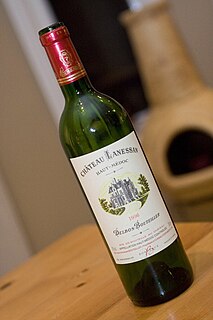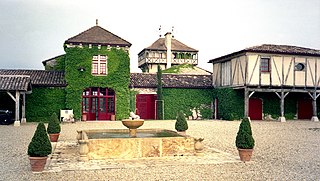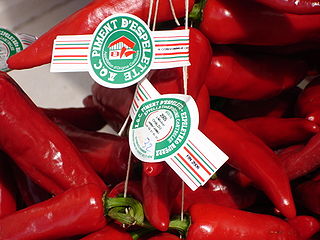
Château Haut-Brion is a French wine, rated a Premier Grand Cru Classé, produced in Pessac just outside the city of Bordeaux. It differs from the other wines on the list in its geographic location in the north of the wine-growing region of Graves. Of the five first growths, it is the only wine with the Pessac-Léognan appellation and is in some sense the ancestor of a classification that remains the benchmark to this day.
Château Lascombes is a winery in the Margaux appellation of the Bordeaux region of France. The wine produced here was classified as one of fifteen Seconds Crus in the original Bordeaux Wine Official Classification of 1855. In the 1950s, the estate was purchased by French wine writer Alexis Lichine who continued to own part of the estate till 1971 when Bass Charrington took over principal ownership. In 2001 it was purchased by Yves Vatelot and US-based Colony Capital, who in 2011 sold it to the French insurance group MACSF. In addition to its premier cuvee, a second wine is also produced, under the name Chevalier de Lascombes. Additional brands are Château Segonnes, Rosé de Lascombes, Vin Sec Chevalier de Lascombes and Gombaud.

Château Haut-Bailly is a Bordeaux wine from the Pessac-Léognan appellation, ranked among the Crus Classés for red wine in the Classification of Graves wine of 1953 and 1959. The winery and vineyards are located south of the city of Bordeaux, in the commune of Léognan.
Château Chasse-Spleen is a winery in the Moulis-en-Médoc appellation of the Bordeaux region of France, just north-west of Margaux. Château Chasse-Spleen was selected as one of six Crus Exceptionnels in the Cru Bourgeois classification of 1932, and through later revisions until the annulment of the classification in 2007. The estate is today widely considered to be of cru classé standard.
Château Ausone is a Bordeaux wine from Saint-Émilion appellation, one of only four wines, along with Château Angélus, Château Cheval Blanc and Château Pavie to be ranked Premier Grand Cru Classé (A) in the Classification of Saint-Émilion wine. The winery is located on the Right Bank of France’s Bordeaux wine region in the Gironde department, close to the town of Saint-Émilion.

Château Climens is a Premier Cru Classé Sauternes wine producer from the Barsac appellation. The estate is located in the southern part of France’s Bordeaux wine region in the district of Graves, an eighth of a mile away from Barsac's other most historically rated vineyard, Château Coutet.

Château Lanessan is a Bordeaux wine estate in the Haut-Médoc appellation, located on the Left Bank of France’s Bordeaux wine regions in the commune of Cussac near Fort Médoc. The estate held a rating of Cru Bourgeois Supérieur, until this specific classification was annulled. Some critics have suggested that it ought to be elevated to a higher classification.

Château Grand Corbin-Despagne is a wine from the Saint-Émilion appellation of the Bordeaux wine region of France, ranked a Grand Cru in the Classification of Saint-Émilion wine. The winery is located in the northern part of the Saint-Émilion commune, close to the border of Pomerol.

Château la Mission Haut-Brion is a Bordeaux wine from the Pessac-Léognan appellation, classed among the Crus Classés in the Graves classification of 1953. The winery, located in close vicinity of the city of Bordeaux, belongs to the wine region Graves, in the commune of Talence with additional property in Pessac.

The wines of Graves in the wine-growing region of Bordeaux were classified in 1953 by a jury appointed by Institute National des Appellations d'Origine, and approved by the Minister of Agriculture in August of that year. The selection was revised with a few additions in February 1959. The classification concerns both red and white wines, and all chateaux belong to the appellation Pessac-Léognan, which eventually came into effect on September 9, 1987.
Domaine de Chevalier is a Bordeaux wine from the Pessac-Léognan appellation, ranked among the Crus Classés for red and white wine in the Classification of Graves wine of 1953 and 1959. The winery and vineyards are located south of the city of Bordeaux, in the commune of Léognan. It is one of a very few Bordeaux estates to be named domaine instead of château.
Château Pape Clément is a Bordeaux wine from the Pessac-Léognan appellation, ranked among the Crus Classés for red and white wine in the Classification of Graves wine of 1959. It is the oldest wine estate in Bordeaux, harvesting its 700th vintage in 2006. The winery and vineyards are located in the commune of Pessac, south-west of the city of Bordeaux. When the estate was omitted from the initial Graves classification of 1953 it caused some controversy.

Château Malartic-Lagravière, originally Domaine de Lagravière, is a Bordeaux wine from the Pessac-Léognan appellation, ranked among the Crus Classés for red and white wine in the Classification of Graves wine of 1953 and 1959. The winery and vineyards are located south of the city of Bordeaux, in the commune of Léognan.

Château Smith Haut Lafitte is a Bordeaux wine from the Pessac-Léognan appellation, ranked among the Crus Classés for red wine in the Classification of Graves wine of 1953 and 1959. The winery and vineyards are located south of the city of Bordeaux, in the commune of Martillac.
Château d'Angludet or Château Angludet, is a Bordeaux wine estate in the appellation Margaux, in the commune of Cantenac on the left bank of the Gironde. The estate was classified a Cru Bourgeois Exceptionnel in 1932, and most recently a Cru Bourgeois Supérieur in 2003, in a classification which has been inactive since 2007.
Château Couhins-Lurton is a Bordeaux wine from the Pessac-Léognan appellation, ranked among the Crus Classés for dry white wine in the Classification of Graves wine of 1959. The winery is located in close vicinity of the city of Bordeaux, in the commune of Villenave-d'Ornon.
Chateau Woltner, formerly Nouveau Medoc Vineyard, was a California wine estate located near Angwin, California in the Howell Mountain AVA within Napa Valley, which in the modern era was operational between 1980 and 2000 before its sale and merge into Ladera Vineyards.
Château La Tour de Mons, archaically named Tour de Marsac, is a winery and wine from the appellation Margaux, located in the Left Bank of the Bordeaux wine region of France, in the commune of Soussans. The wine was rated Cru Supérieur in the Cru Bourgeois classification of 1932, and through later revisions until the temporary annulment of the classification in 2007.












